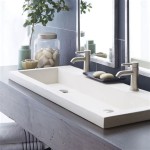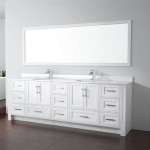Why You Shouldn't Drink Water From The Bathroom Tap
Access to clean and safe drinking water is fundamental for human health. While many sources provide potable water, not all taps are created equal. Specifically, the water dispensed from bathroom taps often presents potential health risks that warrant careful consideration. This article will explore the reasons why drinking water from the bathroom tap is generally discouraged, focusing on the potential contaminants present and the plumbing configurations that increase the risk of exposure.
Potential Contaminants in Bathroom Tap Water
The quality of water flowing from a bathroom tap is affected by several factors, primarily relating to plumbing materials and the frequency of use. Unlike kitchen taps, which are often used frequently for drinking water and food preparation, bathroom taps may experience periods of stagnation. This stagnation can lead to the leaching of contaminants from pipes and fixtures into the water supply.
Lead is a primary concern. Older plumbing systems, particularly those installed before the lead ban in 1986, may contain lead pipes or lead solder connecting copper pipes. Lead can dissolve into water, especially when the water sits stagnant in the pipes for extended periods. Even in newer homes, brass fittings, although generally lead-free, can still contain a small percentage of lead. Lead exposure, even at low levels, can cause serious health problems, particularly in children and pregnant women. It can lead to developmental delays, learning disabilities, and behavioral problems in children, and can affect blood pressure and kidney function in adults.
Copper is another metal that can leach into water from copper pipes, especially when the water is acidic (low pH). Although copper is an essential nutrient, excessive levels can cause gastrointestinal distress, such as nausea, vomiting, and diarrhea. Long-term exposure to high levels of copper can also lead to liver and kidney damage. The blue-green stains sometimes seen around bathroom fixtures are often an indication of copper corrosion and potential copper contamination of the water. The presence of these stains should serve as a warning sign not to drink the water.
Plastic pipes, such as PVC and CPVC, are increasingly used in modern plumbing systems. While generally considered safe, these pipes can leach volatile organic compounds (VOCs) into the water. These VOCs can come from the manufacturing process of the pipes or from the adhesives used to join them. While the levels are usually low and within acceptable limits, certain VOCs are known carcinogens. Stagnant water, especially in warmer temperatures, can exacerbate the leaching process.
Bacteria growth is another concern associated with infrequent use of bathroom taps. Water that sits stagnant in pipes provides an ideal environment for bacteria to multiply. Biofilms, which are thin layers of bacteria and other microorganisms, can form on the inside of pipes. These biofilms can harbor harmful bacteria, such as Legionella, which can cause Legionnaires' disease, a severe form of pneumonia. While Legionella is more commonly associated with large water systems, such as those found in hospitals and hotels, it can also grow in home plumbing systems, especially in bathrooms that are not used regularly.
Furthermore, the location of the bathroom tap within the home can influence water quality. Bathrooms are often located further away from the main water line entering the house. This means that water has to travel a longer distance through the plumbing system to reach the bathroom tap, increasing the opportunity for contaminants to leach into the water. The longer the water remains stagnant in the pipes, the greater the concentration of contaminants that may be present.
Plumbing Configurations and Potential Cross-Contamination
The plumbing configurations in bathrooms often present a greater risk of cross-contamination compared to the plumbing in other areas of the home, such as the kitchen. This is due to the proximity of the toilet and other potential sources of contamination to the water supply lines for the bathroom tap.
One major concern is the potential for backflow or back-siphonage. Backflow occurs when the water in a plumbing system flows in the reverse direction, potentially drawing contaminated water into the potable water supply. This can happen due to a drop in water pressure in the main water line, creating a vacuum that sucks water back from fixtures such as toilets or bidets. If the toilet tank refill valve is not properly functioning, water from the toilet tank, which contains bacteria and other contaminants, can be drawn back into the water supply lines and potentially contaminate the water flowing from the bathroom tap. Although backflow preventers are required in many jurisdictions to prevent this from happening, they are not always present or properly maintained.
The close proximity of the drain lines to the water supply lines in the bathroom also increases the risk of contamination. If there is a leak in a drain line, contaminated water can seep into the surrounding area and potentially contaminate the water supply lines. This is especially a concern in older homes where the plumbing may be corroded or damaged.
Moreover, the types of fixtures commonly found in bathrooms, such as toilets and showers, can contribute to water contamination. Toilets, in particular, are a significant source of bacteria and other pathogens. Even with regular cleaning, toilets can harbor harmful microorganisms that can potentially contaminate the surrounding environment. Showers can also contribute to water contamination due to the growth of mold and mildew in showerheads and shower stalls. These microorganisms can be aerosolized and inhaled during showering, but they can also contaminate the water supply lines if there is a problem with the plumbing system.
Alternative Water Sources and Mitigation Strategies
Given the potential risks associated with drinking water from the bathroom tap, it is prudent to seek alternative sources of potable water within the home. The kitchen tap is generally considered a safer option, as it is typically used more frequently and is often connected to a water filtration system.
Installing a water filtration system is a proactive step to improve the quality of drinking water. These systems can remove various contaminants, including lead, copper, chlorine, and bacteria. There are several types of water filters available, ranging from simple pitcher filters to whole-house filtration systems. The choice of filter depends on the specific contaminants of concern and the desired level of filtration. A point-of-use filter installed directly on the kitchen tap can provide filtered water for drinking and cooking.
Regularly flushing the pipes can also help to reduce the concentration of contaminants in water. This involves running the tap for several minutes, especially after periods of stagnation. Flushing the tap removes water that has been sitting in the pipes and allows fresh water to flow through. This is particularly important in bathrooms that are not used frequently.
Maintaining the plumbing system is crucial for ensuring the safety of drinking water. This includes inspecting pipes for leaks or corrosion, repairing any damage promptly, and ensuring that backflow preventers are properly installed and functioning correctly. Replacing older plumbing fixtures, especially those that contain lead, is also a recommended step to reduce lead exposure.
Testing the water quality is another important step to identify potential contaminants and assess the safety of drinking water. Water testing kits are available at most hardware stores, or certified laboratories can conduct comprehensive water analysis. Regular water testing can help to detect problems early and take appropriate action to mitigate risks.
Ultimately, prioritizing access to clean and safe drinking water is essential for protecting public health. While water from bathroom taps may appear to be suitable for drinking, the potential risks associated with plumbing configurations, stagnation, and contaminants warrant caution. By understanding these risks and adopting appropriate mitigation strategies, individuals can minimize their exposure to harmful substances and ensure access to safe and healthy drinking water from alternative sources within the home.

Is It Safe To Drink Water From Your Bathroom Tap
People Are Only Just Discovering Why You Shouldn T Drink Water From The Bathroom Tap
How To Tell If Water Is Safe Drink Or Contaminated

Is It Safe To Drink Bathroom Sink Water

Why You Shouldn T Drink Water From The Bathroom Tap If Live In This Type Of House Coventrylive

Reason Why You Should Never Drink Water From Bathroom Tap Explained Mirror

Is Bathroom Tap Water Safe To Drink Experts Explain Why You Shouldn T Hngn Headlines Global News
How To Tell If Water Is Safe Drink Or Contaminated

Experts Explain Why Drinking Water From Your Bathroom Tap Could Pose A Health Risk Chronicle Live

Is It Safe To Drink Water From The Bathroom Tap Glasgow Live
Related Posts







